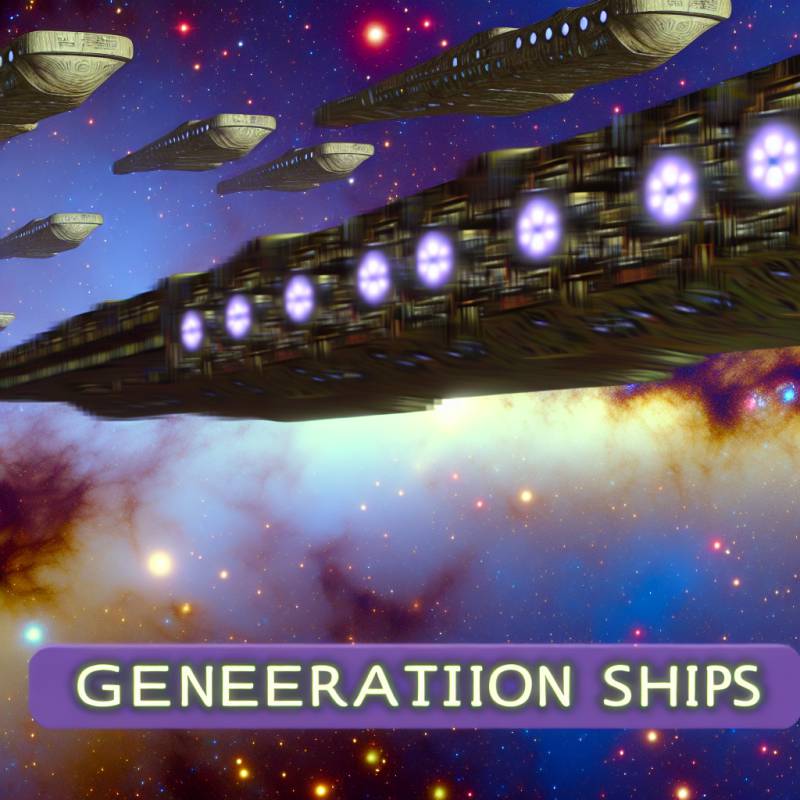The Viability of Human Survival on Generation Ships: A Deep Dive
Imagine a colossal spaceship, a self-sustaining world in itself, traversing the vast expanse of the cosmos. This is not a scene from a science fiction novel, but a concept that scientists and space enthusiasts have been toying with for decades – generation ships. These are spacecraft designed to support human life for centuries, allowing generations of people to live and die on board while the ship is in transit to distant star systems. But the question that has been plaguing scientists and enthusiasts alike is: Can humans really survive in interstellar transit?
The idea of generation ships is not new. It was first proposed in the early 20th century as a solution to the problem of interstellar travel. Given the vast distances between stars, even traveling at the speed of light, it would take us four years to reach the nearest star, Proxima Centauri. At the speeds achievable with current technology, the journey would take tens of thousands of years. Hence, the concept of a generation ship, a vessel that could support human life for such extended periods, was born.
However, the viability of human survival on generation ships is a complex issue that goes beyond the mere provision of food, water, and air. It involves a deep dive into the realms of biology, psychology, sociology, and even ethics.
From a biological perspective, the challenges are immense. The ship would need to be a closed ecosystem, recycling all waste and producing all food onboard. It would need to maintain a stable population, which means controlling birth and death rates. There would also be the risk of disease outbreaks, which could be catastrophic in a closed environment. Moreover, over the course of centuries, the population could evolve, adapting to the unique conditions of life on the ship.
Psychologically, the inhabitants of a generation ship would face unique challenges. They would be born, live, and die in the same environment, with no possibility of ever setting foot on a planet. The psychological impact of such a confined existence is hard to predict. There could be issues of stress, depression, and a sense of purposelessness.
Sociologically, the ship would need to maintain a stable society for centuries. This would require a form of governance, laws, and social structures. There would be the risk of societal breakdown, conflict, and even rebellion.
Ethically, there are questions about the right to confine people to such an existence. The first generation of inhabitants would choose to embark on the journey, but subsequent generations would be born into it with no choice. Is it ethical to condemn people to live and die in transit, with no possibility of ever reaching the destination?
Despite these challenges, the idea of generation ships continues to captivate us. It represents the ultimate human adventure, the exploration of the final frontier. It is a testament to our curiosity, our ambition, and our indomitable spirit.
In conclusion, while the viability of human survival on generation ships is fraught with challenges, it is not an impossibility. It would require advances in technology, a deep understanding of human biology and psychology, and a rethinking of our social and ethical norms. But if history has taught us anything, it is that humans are capable of extraordinary feats when driven by curiosity and the desire to explore the unknown.
Interstellar Transit: Can Generation Ships Sustain Human Life?

Imagine a colossal spaceship, a self-sustaining world, carrying thousands of people across the vast expanse of space. This is not a scene from a science fiction novel, but a concept that scientists and futurists have been contemplating for decades: generation ships. These are spacecraft designed to support human life for centuries, allowing multiple generations to live and die aboard as they journey to distant stars. But the question remains: can humans really survive in interstellar transit?
The concept of generation ships is a response to a fundamental problem in space travel. Even at the speed of light, it would take four years to reach the nearest star, Proxima Centauri, and tens of thousands of years to reach more distant stars. Conventional spacecraft simply cannot carry enough fuel for such journeys. Generation ships, on the other hand, would travel at a fraction of the speed of light, taking centuries or even millennia to reach their destinations.
The idea is that the original crew would live out their lives on the ship, having children who would do the same, and so on, until their descendants finally arrived at the destination star. The ship would need to be a closed ecosystem, recycling air, water, and waste, and producing food. It would also need to provide for the physical and psychological needs of its inhabitants, offering space for living, working, and recreation.
However, the challenges of creating such a ship are immense. The first is the sheer scale of the project. A generation ship would need to be large enough to support a viable population for hundreds of years. This means not just enough people to avoid inbreeding, but also enough to maintain a complex, technologically advanced society.
The second challenge is the closed ecosystem. While we have some experience with this from projects like Biosphere 2, we are far from being able to create a self-sustaining ecosystem that can last for centuries. The ship would need to recycle everything, with no room for error or waste. It would also need to be resilient to unexpected problems, from disease outbreaks to equipment failures.
The third challenge is the human factor. How would people react to living their entire lives on a spaceship, knowing they will never see their destination? How would society and culture evolve over generations? These are questions that cannot be answered with certainty, and they pose significant risks to the success of the mission.
Despite these challenges, the idea of generation ships continues to captivate us. It speaks to our innate desire to explore, to push the boundaries of what is possible. It also raises profound questions about what it means to be human, and how we might adapt to life in the stars.
In conclusion, while the concept of generation ships is fascinating, it remains firmly in the realm of speculation. The technological, ecological, and psychological challenges are immense, and we are likely centuries away from being able to build such a ship. But as we continue to explore the universe and develop new technologies, who knows what the future may hold? Perhaps one day, our descendants will indeed set sail on a generation ship, embarking on an epic journey to the stars.
Generation Ships: Assessing the Reality of Human Survival in Space
Imagine a colossal spaceship, a self-sustaining world in itself, carrying thousands of humans on a multi-generational voyage to distant stars. This is the concept of a generation ship, a theoretical solution to the vast distances and time scales involved in interstellar travel. But can humans really survive in interstellar transit? Let’s delve into the reality of human survival in space.
The idea of generation ships is not new. It has been a staple of science fiction for decades, from Robert Heinlein’s “Universe” to the recent movie “Passengers.” The concept is simple: if we can’t travel faster than light, we’ll have to take the long way around. We’ll build a ship so large and so self-sufficient that it can support human life for centuries, if not millennia. The passengers on board will live, work, reproduce, and die, with their descendants carrying on the mission until they reach their destination.
However, the reality of implementing such a concept is fraught with challenges. The first and most obvious is the sheer scale of the project. Building a ship capable of supporting human life for centuries would be an engineering feat unlike any other. It would need to be self-sustaining, with systems for recycling air and water, growing food, and generating power. It would also need to be incredibly durable, able to withstand the rigors of space travel for hundreds of years without maintenance or repair.
Then there are the biological challenges. Humans evolved to live on Earth, under specific conditions of gravity, radiation, and atmosphere. Long-term exposure to the conditions of space can have serious health effects, including bone loss, muscle atrophy, and increased risk of cancer. We would need to find ways to mitigate these effects, or to adapt our bodies to the new environment.
But perhaps the most daunting challenges are psychological and social. How would people react to living their entire lives in a confined space, knowing they will never set foot on a planet? How would society evolve over generations, without the influence of external cultures or the possibility of emigration? These are questions that we can’t answer with certainty, but they are crucial to the success of a generation ship.
Despite these challenges, the idea of generation ships remains compelling. It represents a bold vision of human exploration and colonization of the stars. It’s a testament to our species’ drive to explore, to push the boundaries of what is possible. And it’s a reminder that, even in the face of seemingly insurmountable obstacles, we can find solutions if we’re willing to think big and take risks.
In conclusion, while the concept of generation ships presents significant challenges, it also offers a tantalizing possibility for the future of human space travel. It’s a concept that requires us to think deeply about our capabilities, our limitations, and our willingness to venture into the unknown. Can humans really survive in interstellar transit? The answer is still up in the stars, but with our relentless curiosity and ingenuity, we might just find a way.



